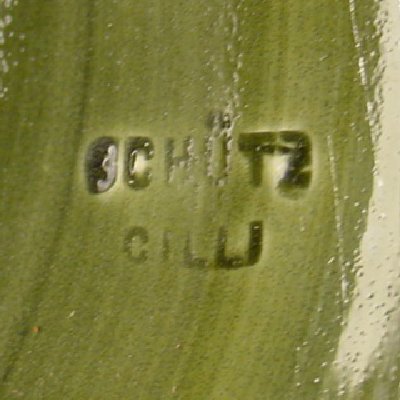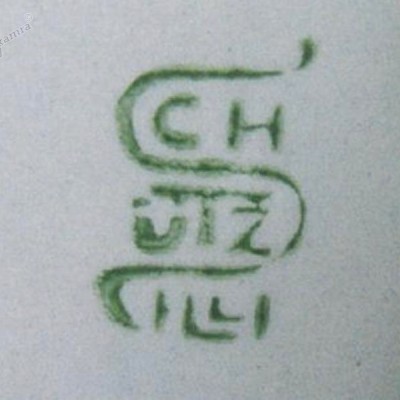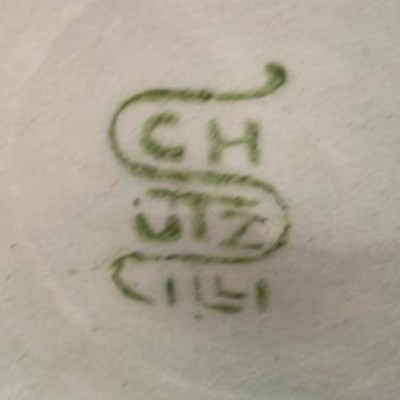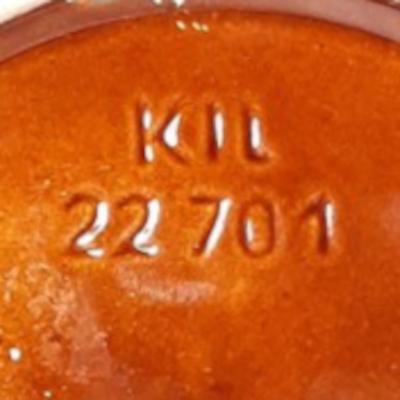
Image 020402-01-01
Used from 1870 onward.
This was the second subsidiary claimed to have been founded by the Gebrüder Schütz Handelsgesellschaft in 1870 and various sources quote its name as being something in the direction of Thonwaarenfabrik Gebrüder Schütz. This may well have been a name included in some registration papers during its founding, however various newspaper adverts published a short time later (e.g. 1876-AUG-22) already clearly state that the facility in Liboje was as early as 1875 actually named Thonwaarenfabrik L.R. Schütz, long before the brothers decided to divide their company assets.
From its creation onward the facility was not only involved in clay mining operations in Liboje itself but later also supervised operations in Flöhau (Blšany) as well as the clay and quartz sand pits in Dubovac near Karlstadt. A short note on that: letter head proof clearly reads Dubovac. Various "experts" in this context state "Karlovac/Karlovec near Karlstadt" and it is obvious that they mindlessly copied that nonsense from each other as Karlovac is the Croatian (and Karlovec the Slovenian) name of Karlstadt itself.
One common misconception here is that the term "Thonwaaren" (old spelling form, today "Tonwaren") is that it always refers to completed earthenware or pottery, as it commonly does today. In its original industrial meaning however it descibed all goods required to produce the required clay, including feldspar and quartz. That of course explains the misleading info regarding the business expansion towards Liboje as it was not a ceramics production facility (at first) but established as mining and milling facility, providing raw materials (including color/glaze mixtures) for various facilities. It is a documented fact that the Liboje business still supplied the original factory in Olomuczan even after the brothers had divided the company assets.
Anyway, a few sources mention that the Gebrüder Schütz business used enamel colors and glazes developed by senior civil servant Kosch, head of the chemical-technical Research Institute of the Austrian Museum. That is not quite correct as Kosch explicitly licensed Ludwig Richard Schütz with production, use, and wholesales of the patented mixtures over a period of five years from 1876 onward, with production taking place in Liboje. A corresponding entry was printed in the offical publication of the Austrian Museum of Art and Industry ("Mittheilungen des k.k. Österreichischen Museums für Kunst und Industrie") from 1876.
It is also mentioned in the publications of the Austrian Museum of Art and Industry ("Mittheilungen des k.k. Österreichischen Museums für Kunst und Industrie") from 1883 that L.R. Schütz "from Cilli" had gifted the museum with a cup painted according to the sketches of Missner, scholar of Professor Berger.
Over time the small kilns used for test firings whilst experimenting with colors and glazes were upscaled and also used for production. The resulting utility ceramics were normally produced as plain whiteware but could also be purchased as fully decorated or colorfully glazed items as the small room formerly used for mixing and testing colors and glazes had slowly become a decoration studio. Part of the product range included beer/cider sets (central jug plus set of mugs), planters, wash basins & jugs as well as a wide range of ivory glazed items for decorative purposes, like jugs, plates, vases and such. The facility name was changed acordingly, even though business still included the mining and milling operations at first.
In 1904 finally, the production of firebricks and related products was dropped as the factory had started to concentrate on majolica and ceramics only.
Following the First World War, business for Austrian and German companies in the region became increasingly difficult. Families which had lived in the area for generations were suddenly viewed and treated as outcasts, their companies and businesses ignored, no matter how they had stood during the conflict. Compensation was sought for war damage, and calls for expropriation of such undesired businesses grew louder each day. The Liboje facility still had 80 employees when Marie Charlotta Schütz-Lobe decided to give up in 1919, selling everything to the Abel family and retiring to her villa in Meran (Italy) where she concentrated on landscape painting and eventually died peacefully in the year 1946.
The Abel family itself was an old Austrian family of industrials with many different business operations including the production of glass, ceramics, paper and cement as well as various ore and coal mines in Slovenia and Croatia. Over time the family had purchased many of the ceramics facilities in the Cilli region, eventually creating the majolica brand Majolika Celeja. They had initially also been threatened by expropriation, but their influence and timely application for Yugoslavian citizenship prevented this. Of course this switch of citizenship was held against them after German troops invaded Yugoslavia in 1941. And even if their influence and connections once again saved their necks at that time they were helpless against threats of assassination by the Tito partisans after the Second World War, forcing them to flee the country.
The whole business was nationalized and its name changed to Keramična Industrija Liboje, continuing business with the hundreds of still existing Schütz mother forms and molds. Times and tastes had however greatly changed and so the factory was not nearly as successful as its predecessors. After Yugoslavia fell apart in 1991 the company was reprivatized, facing bankruptcy around a decade later.
Things greatly improved when the facility in Liboje was taken over by the Bojnec family. Alojz Bojnec sr. had made his name with a pottery workshop in the well known village of Filovci duirng the late 1940s. With growing demand and recognition of quality products, business expanded under Alojz Bojnec jr.; shortly afterwards their products were once again exported to foreign markets.
At a time where other European producers gave up or decided to shift production to Asia, Keramika Liboje took up the challenge to maintain Slovenian ceramic production and preserve traditions while at the same time remain competitive and innovative, not only in matters of flameproof stoneware.
The first three marks show below can not be clearly attributed to either the Pletrowitsch or Liboje production location; these mark types are therefore shown on both pages.

Image 020402-01-01
Used from 1870 onward.

Image 020402-01-02
Used from 1890 onward.

Image 020402-01-03
Another example, showing that the U-Umlaut was not a plain "U".
Picture by Mary Alioto)

Image 020402-06-01
Example of the plain "KIL" mark used around 1970.
© 2004-2025 C.S.Marshall, all rights reserved